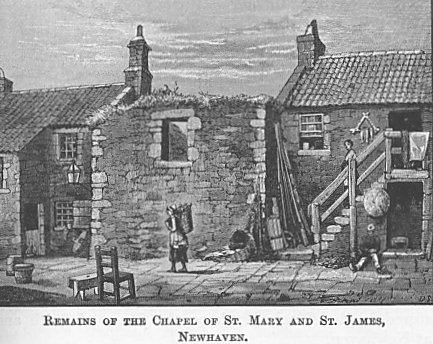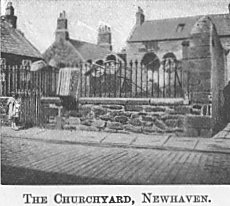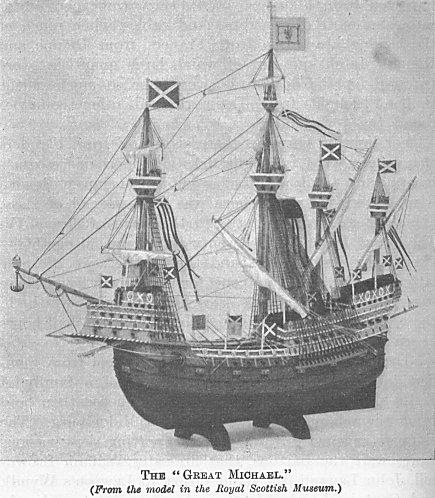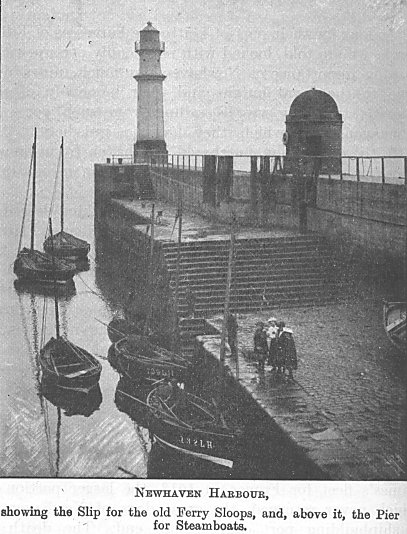WHILE we know the names of a large number of Scottish
ships belonging to James IV.’s time, we cannot always distinguish the
vessels of the king from those of other owners. A recent great writer of
Scottish history, however, estimates that the navy of James at its best
consisted of sixteen large ships and ten small ones. Such a large fleet of
royal vessels shows us that, even although the king sometimes purchased
ships from abroad, his own dockyards at home must also have been unusually
busy.
The Margaret was perhaps the largest Scottish
vessel then afloat; but James was ambitious to possess ships still larger.
From the difficulties encountered by the ingenious Jacques Terrell, James’s
master wright and chief naval designer, in floating the Margaret over
the entrance of her dockyard at the Shore it was evident there was not
sufficient depth of water to permit of the construction of larger vessels
at Leith. But by men like James IV., Sir Andrew Wood, and the Bartons,
this difficulty was soon overcome. Little more than a mile farther west
the depth of water at high tides was much greater than at Leith, and there
the king resolved to construct new dockyards for the building of larger
ships, while he still retained those at Leith for constructing vessels of
normal size. This resolution had no sooner been arrived at than work was
begun, and even before the Margaret was ready for sea the Novus
Portus de Leith—that is, the New Haven or Harbour of Leith, and now so
well known as the fishing village of Newhaven—was in process of
formation.
The land on the west side of the Water of Leith,
however, did not belong to the king. It was the property of the abbot and
canons of Holyrood, and would require to be purchased from them before any
new harbour could be constructed there; but the royal ships and shipyards
had already cost so much that Sir Robert Barton, the clever keeper of the
king’s purse, had little money wherewith to indulge in any new
expenditure. But difficulties only appeared to be at once overcome; for
the king gave the abbot and canons a portion of his rich lands in and
around Linlithgow for some acres of the grassy lands so long known as the
Links of North Leith, of which all that remains to-day is the Free
Fishermen’s Park adjacent to the Whale Brae.
In 1504 trees to the number of one hundred and
sixty-three were purchased from the Laird of Inverleith for the
construction of the new village. The labourers employed in this work were
lodged in a great pavilion brought from Edinburgh Castle and erected on
the grassy links until houses were built. But housing was pushed on
rapidly, and Newhaven became ere long quite a large village and the seat
of a considerable population, of whom many were French, some Flemings, and
others Dutch. Mingled with these were a few Spaniards, Panes, and
Portuguese.
As James, like his mother before him, was devoted to
the Church, he early made provision for the spiritual welfare of his many
shipwrights and other workmen at Newhaven. We find that the building of a
chapel dedicated to the Virgin and St. James was going on in 1505, and in
little more than a year afterwards we see it open for service and the king
presenting it with a silver chalice or communion cup. The only remains of
this chapel to be found in Newhaven to-day are the west gable of the nave
which stands on the right as you go down the Westmost Close, and its
little God’s-Acre which forms a green enclosure adjacent in Main Street.
Our ancestors in these old times had a happy gift of putting much poetry
into their place-names, and so, from the fact of their chapel being
dedicated to the Virgin, Newhaven was commonly known by the highly poetic
name of Our Lady’s Port of Grace.

As the building of a fleet was an undertaking very dear
to James’s heart, we soon find him showing the greatest interest in the
construction of the New Haven by frequent visits to the works from his
royal palaces at Holyrood and Linlithgow, and by encouraging the workmen
with gifts of the inevitable "drink-silver," as in 1504, when he
sent fourteen shillings by the hand of Sir Robert Barton to "the
marinaris that settis up the bulwerk of the New Haven." Three years
later, in 1507, the works were still being extended, for in that year we
find another bulwark erected and a new dock being excavated.
 No
sooner was the first dock ready than shipbuilding began, and preparations
were made for the construction of a warship superior to any yet afloat. We
find timber and other material for the "great schip," afterwards
known to fame as the Great Michael, being brought from many
quarters and stored in the King’s Wark on the Shore of Leith and at
Newhaven.
No
sooner was the first dock ready than shipbuilding began, and preparations
were made for the construction of a warship superior to any yet afloat. We
find timber and other material for the "great schip," afterwards
known to fame as the Great Michael, being brought from many
quarters and stored in the King’s Wark on the Shore of Leith and at
Newhaven.
This great ship seems to have been laid on the stocks
about 1507, and her construction was carried out under the superintendence
of Sir Andrew Wood, perhaps the greatest of James’s many sea captains.
In a poem addressed to the king himself by William Dunbar, the famous
Scots poet of that time, we have a brief but graphic word-picture of the
stir and bustle that reigned in the naval yards of Leith and Newhaven at
this period—a word-picture undoubtedly suggested by what he had so often
seen at these places with his own eyes. In this poem Dunbar talks of the
"Carpenters,
Builders of barks and ballingars,
Masons lying upon the land,
And shipwrights hewing upon the strand."
To Lindsay of Pitscottie, in Fife, perhaps the most
picturesque and attractive writer of Scots history, we owe much
interesting information about the building of the Great Michael. Although
doubt has been thrown on many of the details of his graphic narrative, yet
we must remember that Pitscottie was near neighbour to the Woods of Largo,
and is therefore likely to have had authentic information about Sir Andrew
and the great ship of which he was commander. Pitscottie, after the manner
of the old balladists, tells us that the Great Michael was "a
year and a day" in building; but that is only his picturesque Scots
way of saying that she took a long time to build, and we know from other
sources that she must have been on the stocks for four years at least.
During this long period James took the deepest interest
in every detail of her construction, and was therefore a frequent visitor
to Newhaven, where his kindly consideration and attractive manner, as in
Leith, Soon won for him the devoted and affectionate loyalty of the whole
population. No accident to any of the workmen and no case of sickness
among the villagers ever failed to call forth his kindly sympathy and
ready help. We find him giving fourteen shillings to "ane pure wyff
becaus hir husband brak his leg at the king’s werk and had nathing to
amend it with." One of his French shipwrights died and was buried in
the little churchyard of St. Mary’s Chapel. The king not only paid all
the expenses of the illness and burial, but also sent the widow back to
her native Rouen to which she longed to return. Even the poor charwoman
who kept the court that led to the works is not forgotten when she
"is fallen seik." The king’s courteous and kindly bearing
encouraged even the humblest of his subjects to approach him with freedom.
There must have been fishermen in Newhaven even in
those early days of its history, for we find James going with them to the
oyster-dredging. As the fishers were accustomed to sing songs while at
work, and the king was passionately fond of music, we may be sure the
"dreg song" was struck up on these occasions, for
"The oysters are a gentle kin’,
They winna tak unless ye sing."
In 1506, a year when summer days were more than usually
fine, a Newhaven woman brought the king the first strawberries of the
season, a fruit for which James had a particular fondness, while on
another occasion he received a gift of plums "at the bridge end of
the New Haven." Again we see him later in the same season purchasing
"hony peris" from a fruitseller at the pier end. A pleasant
place evidently was this Newhaven of long ago, with its cottages set in
shady gardens, gay with blossom in the pleasant springtime, and rich with
fruit in mellow autumn, the honey pears and the plums in all likelihood
from trees grown from slips brought by James’s French shipwrights from
the sunnier and warmer shores of Normandy and Brittany.
Sometimes King James rode down from Holyrood in the
early morning on his favourite steed Grey Gretno, when the exercise and
fresh morning air put rather a keen edge on his appetite. On such
occasions, there being no inn at this time in Newhaven, he "disjonit"
(French déjeuner—to breakfast) at the house of one of his French
shipwrights, whose wife was seemingly known to local fame as a cook
skilled beyond her neighbours. Royal visits were everyday incidents in
Newhaven in those distant days.
Perhaps the most pleasing Newhaven memories associated
with those of James IV. are connected with the nameless little Newhaven
girl to whose identity we have no clue whatever, for the king never speaks
of her except as "the little lass." Children, unless they are of
royal blood, do not figure largely in State documents, and are not often
met with in local history. King James, however, always seemed to be
specially interested in them; it might be because he had lost so many of
his own, "which grevit him sae sair that he tvald not be
comforted." He possessed in a very high degree all that charm of
manner so characteristic of the Stuarts, which drew to him both young and
old. At Newhaven we see James’s love for children shown in his interest
in this little nameless lass, whose charm and grace of manner seem to have
been no less attractive than his own, and whose little heart he was wont
to make glad on his visits to his dockyards with the small money gift of a
groat, perhaps to buy strawberries from one of those sunny gardens where
they used to ripen so early, or, if autumn were the season, to purchase
honey pears from the fruitseller at the pier end. What an interesting
story of child life in the days when James IV. was king might be written
round the title, "The Little Lass in Newhaven."
During the years 1508-11 we know little of what went on
in Newhaven, as the king’s accounts for those years have not come down
to us. The Great Michael, by far the largest ship built in Europe
in those days, was still on the stocks. The best account we have of this
great ship is from the pen of that picturesque old chronicler, Pitscottie,
whose word-pictures are so often credited with owing much to the free play
of his imagination.
According to Pitscottie, the Great Michael wasted
all the woods of Fife except those of Falkland in addition to all the
timber that was brought from Norway. Here Pitscottie must have put a great
restraint upon his powers of story-telling, for when we examine the
account books we find that he has understated, rather than exaggerated,
the amount of timber used in her construction. Not only were supplies of
timber sought in all parts of Scotland, but they were also largely
imported from the Continent, and especially from France and the Baltic or
"Estland Seys."
The dimensions of the Great Michael, as given by
the same chronicler, were two hundred and forty feet long, thirty-five
feet broad, with sides of oak ten feet thick. With such dimensions as
these, it is not surprising that she wasted all the woods of Fife, and
required in addition many cargoes of timber from Norway and other lands
beyond the sea.
Besides the timber, much of the other material employed
in the construction of this great ship also came from the Continent, and
chiefly, of course, from those countries with which Leith was accustomed
to trade most, such as the Low Countries, France, Scandinavia, Denmark,
and Poland. We see the enmity between England and Scotland that did so
much to hinder their mutual trade in olden times in the fact that tin and
copper from Cornwall were got via Antwerp.
The guns came mostly from Flanders, though many were
made in Edinburgh Castle and stored in the King’s Wark on the Shore.
Hundreds of "gun-stanes "—the general name for cannon balls at
this time—were also imported from Flanders. With them came canvas for
sails, and most of the ropes and cables, while much of the rigging also
came from France—from Dieppe and Rouen. Pitch and tar, of which large
quantities were required for the dockyards, were, like so much of the
timber, brought from Denmark and other countries round the "Estland
Seys."
For lighting purposes there also came from Flanders
chandeliers—that is, candlesticks of a more or less ornamental kind—and
horn for bowets to the ships. Bowets were lanterns in which horn was used
instead of glass, a highly expensive material in the reign of James IV.
The Great Michael had twenty-six bowets altogether - twenty-three
small ones and three large, two of these latter for the stern and one for
her bow. Then there were the "night-glasses," or sand-glasses,
which in those clockless days were used to indicate the hall-hours at sea
as is still done by bells.
The compasses for the ship were also got from Flanders,
and George Paterson, a member of a family of Leith mariners, was
commissioned to choose them and bring them home with his ship from
Middelburg. The skippers engaged in the work of importing these various
stores were the Bartons, that fire-eater William Brownhill, John Lawson
(the name-father to Lawson’s Wynd), and Captain Lamb, of whose family we
have already heard and of which we shall hear still more.

The Great Michael seems to have been
launched in October 1511, but the event is nowhere definitely stated. So
notable an incident, however, could not fail to be celebrated as a gala
day in Newhaven, and so we find payments being made to Scottish trumpeters
"at the outputting of the kingis gret schip." James would be
there and so would Queen Margaret, and with them a brilliant train of
lords and ladies from Holyrood. Congratulations on the success of the day’s
event would be showered from all sides on Sir Andrew Wood and Jacques
Terrell, the master wright, who in those days was designer as well as
builder.
When finally out of the builders’ hands and furnished
with her full equipment, she made a brave show as she rode at anchor some
two miles from the shore, with her richly carved and decorated forecastle,
her huge poop, her four great masts alive with banners and streamers, and
her sails, as was the custom of the age, emblazoned with the royal and
other coats-of-arms.
But even then she gave her commander, Sir Andrew Wood,
and Jacques Terrell, the master wright, no end of trouble, for owing to
her huge size and cumbersome build she was somewhat difficult to navigate.
For this reason she had the misfortune to run aground in one of her early
trips in the Firth, which had not then its shoals and shallows indicated
by buoys as it has to-day. The result was that there were added to her
crew three pilots, who, strangely enough, were all Frenchmen, and whose
duty it was to mark out the deeper channels.
Now that the Great Michael was making such an
imposing show as she lay at anchor in the Roads, and had no further need
of his services aboard her in the meantime, Jacques Terrell sailed for
France in February 1513 with the French ambassador, De la Motte. The
master wright went to France to enlist fourscore French mariners, perhaps
to act as gunners, for the Great Michael. He sailed from Newhaven
in De la Motte’s little bark called the Gabriel. As Will
Brownhill, with three ships under his command, left Leith at the same
time, ostensibly for Flanders to deceive the English spies, but really for
France, he almost certainly joined De in Motte as convoy to his ship, the
little Gabriel, which was freighted with wool fleeces and salted
hides, two of Leith’s staple articles of export.
Ambassadors in those days seemingly joined trade with
diplomacy, and did not disdain to combine a little piracy with both when a
successful opportunity came along. Like her more famous namesake in the
old English ballad, the Gabriel sailed away adventurously to meet
whatever fortune, chance, or Providence might send. Off Flamborough Head
she fell in with an English ship making for Newcastle with a cargo of
wine, which was promptly captured and sent on to Leith with a prize crew.
Now such an exploit was not the unaided work of the
little Gabriel, and, as the prize was sent to Leith, we may
conclude that Will Brownhill and his three ships had not been far off. To
be sure Scotland and England chanced to be at peace at that particular
time, but that counted for little on the high seas, where a state of war
between the mariners of the two countries was the normal condition of
affairs.
At this time, according to the letters of the English
spies, James visited his ships at Newhaven daily, going early in the
morning and remaining until the dinner-hour, which was then at twelve o’clock.
How many ships had been built at Newhaven it is now impossible to say. In
the letters of the spies of Henry VIII. we read of ships in course of
building, but we have no clue to their names.
Just at this very time we have an account from the
English ambassador himself of his visit to Leith and Newhaven. He was as
much spy as envoy, which James, who perhaps suggested the visit, seemed to
guess. James had boasted that the Great Michael carried more guns
than the French king ever brought to the siege of a town. The English
ambassador wrote to King Henry that this was "a great crack," or
lie, but was too polite to say so to James. He, however, went down to
Leith to see the ships for himself, and then went on to Newhaven, but as
some of the largest of the king’s ships, unknown to this rather
sell-satisfied Englishman, were safely out of sight far beyond Queensferry,
he sent a rather disparaging report of the size of James’s navy to his
lord and master in the belief that he had seen the whole of it.
Jealous for their port of Leith, the burgesses of
Edinburgh, we are told, looked with no friendly eye upon the growing
importance of Newhaven, for much injury was done to the royal burghs and
their monopoly of the overseas trade by vessels sailing from such ports as
Newhaven, over which they had no jurisdiction. In 1510, therefore, they
purchased Newhaven from James, whose many expensive enterprises left him
in constant need of money.
The charter granted to the city by the king describes
Newhaven as "the new port called Newhaven, lately constructed by the
king on the seashore between the Chapel of St. Nicholas in the north part
of the town of Leith and the lands of Wardie." From this charter we
further learn that Newhaven had at this time at least one street, the
South Raw. While the burgesses of Edinburgh thus obtained complete control
of Newhaven, they were at the same time bound to uphold the pier and
bulwarks for receiving and protecting the ships and vessels sailing
thereto.
This grant of Newhaven to the city of Edinburgh in no
way interfered with its use as a place for the construction of the king’s
ships, but with the departure of James’s fleet for France in 1513, the
larger portion of which never returned, the great days of Newhaven as a
shipbuilding port came to an end. The death of James at Flodden, the
misrule and lawlessness which followed, and the failure of Edinburgh to
uphold the pier and bulwarks gradually led to its decline. No vestige of
the pier and once busy dockyards erected by James IV. survives in Newhaven
to-day.


